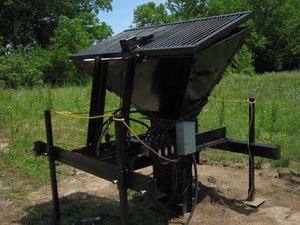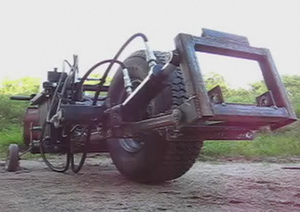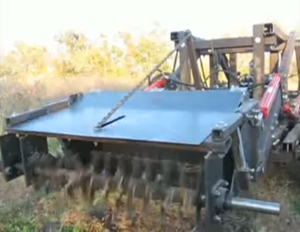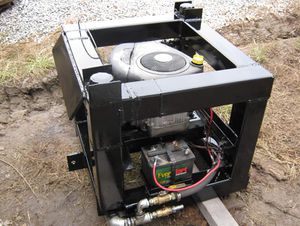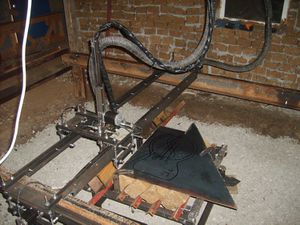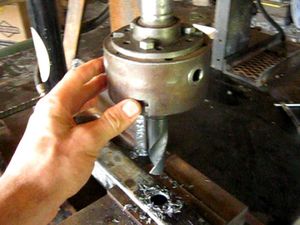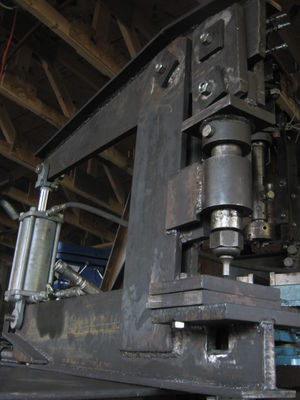Crash course on OSE/es
| Curso Acelerado Esto es un Curso Intensivo sobre Ecología de Código Abierto (OSE por sus siglas en inglés). En los próximos 15 minutos, te actualizarás sobre todo el trabajo de OSE desde 2007 aproximadamente. Escribe a crashcoursemoderator arroba gmail punto com para recibir ayuda. Ver también Resumen Técnico del GVCS. |
Resumen para recién llegados
Para ver lo que hacemos, mira el vídeo: GVCS en 2 Minutos. Ecología de Código Abierto (OSE, siglas en inglés) la fundó en 2004 Marcin Jakubowski. Hoy somos una red de agricultores, ingenieros y colaboradores que en los dos últimos años hemos desarrollado el Equipo de Construcción de la Aldea Global (GVCS, siglas en inglés), de código abierto y bajo coste. Una plataforma de alto rendimiento tecnológico que permite la fácil construcción "DIY" (hágalo usted mismo) de las 50 diferentes máquinas industriales que se necesitan para crear una civilización sostenible con las comodidades modernas. El GVCS reduce las barreras a la entrada en agricultura, construcción y fabricación, y puede visualizarse como un conjunto de herramientas modulares al estilo de un lego a tamaño real, capaces de desarrollar economías enteras, ya sea en la zona rural de Missouri, donde se fundó el proyecto, en el desarrollo urbano o en el corazón de África.
Tenemos un ambicioso programa para lanzar los productos de las 49 tecnologías restantes dentro de 2 años y un presupuesto de 2.400.000 $ - que abreviamos con el nombre de programa 50/2/2. El plazo previsto es 2011-2012.
Características Clave del GVCS
Éstas son las Características Clave del GVCS, y si queréis ver la lista de valores, id a Valores Centrales de la TCA
Key Features
|
Alcance del GVCS
Alcance
|
Estado Actual
actualizado a: 25 abril 2011.
Hemos desarrollado los siguientes prototipos y productos hasta ahora:
| La Prensa LTC (Ladrillos de Tierra Compactada) permite construir a partir de la propia tierra del terreno de forma rápida (16 ladrillos por minuto), a bajo coste y con alta calidad. La Prensa LTC se usa para comprimir terreno arcilloso (20-30% de arcilla en volumen) de tierras locales, convirtiéndolo en bloques de construcción estructurales (700-1000 PSI). La estabilización con cemento se puede usar para hacerlos más resistentes a las condiciones climatológicas. LTC también se presta a la construcción de suelos, áreas pavimentadas, muros de contención, estructuras de almacenamiento o cualquier otra estructura donde se necesiten estos bloques.
Enlaces: El Liberador, The CEB Story, initial field testing, pressing bricks, disassembly, crating (packaging), machine overview, the frame, El controlador, CEB Machine Controller: Fabrication Recursion, Complete CEB Walkthrough. Documentación: Introducción, Instrucciones de contrucción, archivos CAD | |
| LifeTrac es un versátil tractor hidráulico a tamaño completo que gira mediante derrape y con cuatro ruedas. Tiene una potencia de 18-200 hp y las cadenas de oruga de acero son opcionales. El LifeTrac pretende ser minimalista pero de alto rendimiento, diseño de por vida y que permita ser desmontado y con capacidad de trabajo y potencia tales que permitan cualquier operación en el terreno. Destaca su versatilidad y alto nivel de servicio. Su naturaleza modular permite que se le añadan accesorios; los generadores de potencia (Power Cubes) se pueden intercambiar y acumular adaptando la potencia a las necesidades específicas; rápida conexión de todos los componentes hidráulicos mediante mangueras de enganche rápido; incluye motores hidráulicos fácilmente intercambiables para usarlos en otras aplicaciones.
Links: I Estadio de Desarrollo, Prototipo II Completado, moviendo. Documentación: Build (wiki con videos), Blender Files; Quick Attach Plate and Tracks CAD | |
| MicroTrac es una versión retroguiada y en pequeño del LifeTrac para satisfacer la necesidad de un microtractor. Se usan los mismos componentes que en el LifeTrac, “encogiendo” los elementos estructurales – en parte para poder intercambiar parte de sus componentes con el LifeTrac.
Links: Prototype I completed blog post, prototype I completed video, zero turn, Microtrac Prototype II, Prototype II Challenge. Documentación: wiki documentation ; Prototype I Blender File | |
| La Pulverizadora de Tierra se puede enganchar al LifeTrac y pulveriza la tierra hasta convertirla en un fino polvo que se puede usar para la fabricación de los Ladrillos de Tierra Compactada (LTCs).
Links: blog, construcción y test (video corto), test (video). | |
| El Cubo de Energía II es un generador universal, autónomo e independiente que se compone de un motor acoplado a una bomba hidráulica para dar energía a diferentes aparatos en forma de fluido hidráulico presurizado. El Cubo de Energía es un módulo que se puede añadir a las plataformas del LifeTrac, Microtrac, Bulldozer, y del Coche de Código Abierto (CCA). Se conecta a otros aparatos a través de acoplamientos rápidos y mangueras de enganche rápido.
Links: Vídeo corto y largo (50min). Documentación: Blender Files. | |
| La Mesa de Soplete es una mesa de corte. Un ordenador puede controlar la cabeza del soplete para realizar precisos cortes en las tres dimensiones. El Prototipo i se ha construido, pero no ha funcionado satisfactoriamente porque la radiación emitida por el soplete de plasma, en contacto con la mesa, causó un fallo en la electrónica. Terminaremos el Prototipo I reajustándolo con controladores de motores eléctricos de velocidad gradual de código abierto.
Links: wiki page, Plasma cutter in action, Open Source Torch Table Part 4, Part 5, Part 6. Documentación: Build (wiki), Blender File; Prototype I First Fire | |
| La Prensa Taladradora sirve para taladrar agujeros de 2,5 centímetros en adelante directamente sobre el metal sin necesidad de taladrar previamente. Contiene un motor hidráulico para taladrar y un cilindro hidráulico que realiza la presión - por tanto esto es literalmente una prensa y no le falta palanca o potencia puesto que el motor puede aguantar hasta 20 hp. Estamos usando nuestro Rotor Universal para el motor.
Links: video Documentación: documentación | |
| La Máquina Ironworker es un aparato que puede cortar acero instantáneamente y hacer agujeros en metal de 2,5 cm de grosor. Actualmente el Agujereador de 150 Toneladas está en fase de prototipo.
Links: 150 Ton Hole Puncher's blog post Documentación: Hole Puncher's Wiki Docu, Wiki Category |
Actualmente están en fase de prototipo:
CNC Torch Table I
Power Cube III
LifeTrac III
Soil Pulverizer III
Concentrador Solar I
Steam Engine I
Robot Industrial I
La investigación continúa con:
Nickel-Iron Batteries
Ecología de Código Abierto ganó el MAKE Green Project Contest.
Nuestra página web: http://opensourceecology.org
En marzo de 2011, Marcin dió la siguiente micro-charla: TED Talk. Desde entonces, el proyecto llamó la atención y ganó popularidad.
Estamos finalizando:
- la producción de 4 tractores, 4 prensas CEB, 8 Power Cubes, y 2 Soil Pulverizers
- producción de nuestro propio equipamiento: una segunda prensa CEB y más Power Cubes. 2 Tractores con Soil Pulverizers para empezar a construir.
Planes Futuros
We are focusing on demonstrating the effectiveness of our equipment in construction and agriculture duties. For construction, we will be using the open source tractor, CEB press, sawmill, and other supporting tools such as soil pulverizer, cement mixer, auger, backhoe, trencher, hay baler, hay rake, hay cutter, and others. We will demonstrate infrastructure building and housing construction – including double CEB walls filled with strawbales for super-insulation.
We are getting a construction grant of 60k. You can check the GVCS Rollout Plan.
We get a Dimensional Sawmill prototype by Sweiger. We we will prototype a Trencher, Cement Mixer, Auger and other tools for the construction run
The Kickstarter campaign is reorganized for the completion, extended field testing, and documentation of the Tractor, Soil Pulverizer, CEB Press, and Power Cube, providing a firm closure of our first main prototyping cycle of the base agriculture and construction infrastructures.
We are recruiting a Fabrication Manager and Construction Manager, and producing a site survey and architectural plans assuming a budget of up to 100k dolars dedicated to construction. We are further securing a rental unit in Maysville to house 1-2 onsite participants. We further have a documentation team on site, consisting of 2 dedicated people, who are working on full fabrication procedure documentation. We are currently securing our own server for video uploads, CiviCRM, and the ability to handle a large number of hits from Kickstarter. On video, we have almost 1TB of video footage from this production run, to be deployed to a remote video editing team - with a goal of professional quality instructionals on the CEB Press, Tractor, Soil Pulverizer, and Power Cube to be delivered as part of our Christmas Gift. On the legal front, we are trade-marking our identity and donating our land holdings into a trust.
September 15 will be start of the construction run.
October 15 will start our Natural Building Workshop - learn how to do Compressed Earth Brick, Straw Bale, Cut Lumber, Hay Bale, CEB Floors, Cement mixing and others.
Construction business using the Tractor-Soil Pulverizer-Compressed Eearth Brick (CEB) Press package will start in Los Angeles by an early adopter, Joskua Designs. This will be the first field testing outside of Factor E Farm. The building project in California will have to deal with earthquake codes.
We are looking for active collaboration in all projects. Our current needs are:
- Fabrication Manager - finish the existing and continue new production runs, produce further construction equipment necessary for infrastructure buildout. We are planning on prototyping the sawmill, cement mixer, auger, trencher, and backhoe in the 2011 season.
- Construction Project Manager- leading the building new of infrastructure as new people come on site, focusing on natural building techniques such as CEB, local lumber, and local biomass for superinsulation, and bioplastic for greenhouses (see last blog post for details)
- 3 Project Managers – overall global/local project management and integration– utilizing the assistance of a global development team to move forward the creation and testing of the GVCS infrastructure at Factor e Farm
- Machine Designer/CAD – feeds technical design (CAD) into the prototyping process for the GVCS – by providing fabrication drawings to the fabrication team
- 4 Fabricators – custom fabricators and prototypers who convert technical design drawings into physical prototypes – creating the physical substance of the project
- CAM Expert – contributes to the CAM (fabrication automation) aspect of the prototyping process by developing CAM files and by using CNC machines – while streamlining the fabrication process
- Power Engineer – develops the electrical power grid for the community and develops the workshop power supplies – including developing the welder, plasma cutter, induction furnace, inverter, charge controller, and other power electric devices that are included in the GVCS
- Remote Collaboration Support – organizing remote contributor teams for design/CAD/prototyping assistance to Factor e Farm
- CAD/CAM Programmer – A robust, integrated, open source, professional-quality tool chain for CAD/CAM is currently not available. We will put effort into developing such a tool chain to promote the replicability of GVCS tools, by building on and integrating existing tools.
- Land Regeneration Manager – Factor e Farm suffers from serious erosion and fertility issues caused by decades of prior commercial row-cropping. To ameliorate this, our program calls for building berms, ponds, and other earthworks to address erosion directly, plus, extensive mulching, as well as intensive rotational grazing as a rapid way to improve the soil food web. The primary tools that are to be used in these tasks are bulldozers, ruminants, and hay-bales.
- Farmer – or more specifically – the open source agroecologist – the pivotal person in the community who provides nutrition to the FeF team and thereby is the primary contibutor to the good health of the community. The open source agroecologist is responsible for food production – from garden and orchard to field crops, animal husbandry, fishery, and forestry – and for food storage and processing, such as seed cleaning, seed saving, and oil expression. The farmer is responsible for producing food, fuel, and fiber crops (both wood and clothing) – while maintaining a diverse and integrated ecosystem and soil food web that improves in quality over time.
- Cook – feeds the FeF population; engages in crop planning, harvest, and organization of food processing activities
- Web Programmers and User Interface Designers can help with the True Fans Development Proposal.
- check our Project needs.
2012
2012 is rapid parallel development for the completion of the 50 machines. The greater global effort beyond FeF could help tremendously by identifying a large team of qualified, remote developers. Success on the overall 50 machines requires that we recruit a team of bidders/designers/prototypers for each machine – as each machine goes through a multi-step development process from concept to field testing and iteration. This enables us to access large sources of funding. Without a deployment team, we cannot take in money. Thus, if we have a solid team of bidders/designers/prototypers – and their capacities are clear – then we are in a position to move rapidly.
after 2013
After the GVCS completion the first OSE Community will be built and Education and Training in 2-year immersion program are planned.
A Documentary Film about Factory E Farm may come in the future.
Support OSE and collaborate with us to help us make this happen.
Getting Involved
| Get yourself involved! If you liked what you've seen, please check the Get involved page to see the various ways you can contribute your time and skills to our project |
If you want to join quickly some of the project, then check the Guide to OSE Projects.
Media and Interviews
For Interviews, please check our Press Procedure. Here you can find High Resolution GVCS Media.
Keywords
Required Reading for Developers
- OSE Specifications
- Proposal 2012
- GVCS Development Template
- Product Template
- Development Team
- Wiki Policy
- Forum Policy
Other
- Conferences
- Media Development
FAQs
To Do Items
See GVCS Tasks and Project needs.
